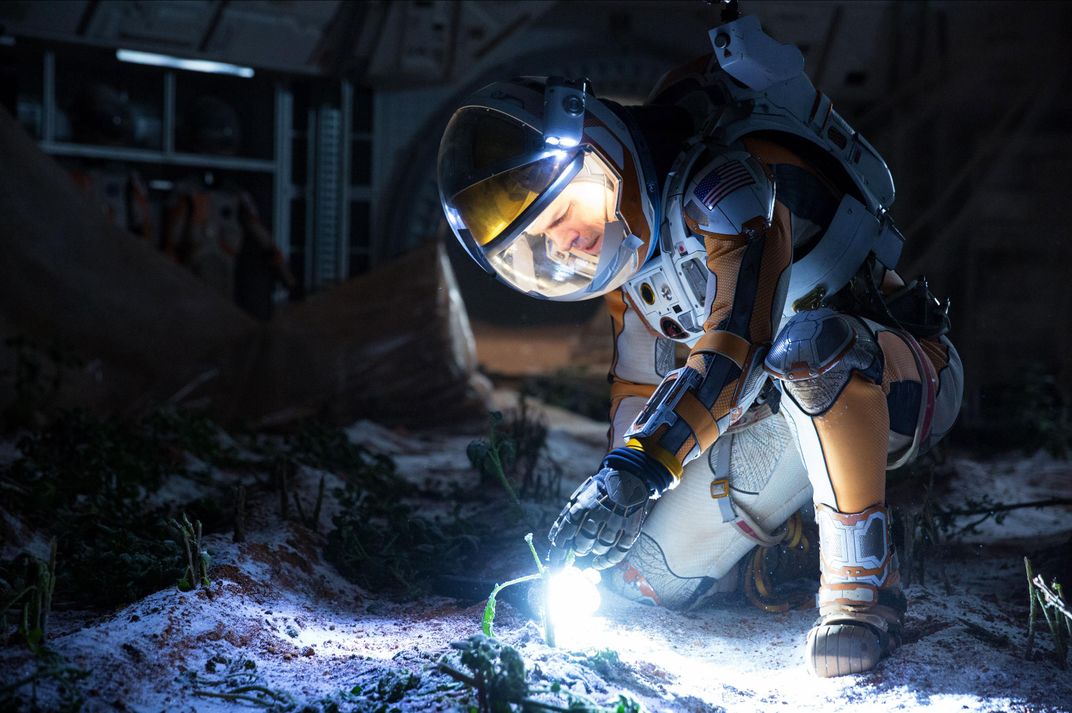The Secret of “The Martian” Success? Scientific Peer Review
Andy Weir’s tale of a stranded astronaut got its start as a blog, complete with reader comments that helped shape the plot
/https://tf-cmsv2-smithsonianmag-media.s3.amazonaws.com/filer/d9/5b/d95b29ab-fae8-4689-a1d3-79c658c1c6a7/martian-pathfinder.jpg)
When Matt Damon signed on to play astronaut Mark Watney in the upcoming film The Martian, he probably didn't know he would be portraying the planetary science version of Schrödinger's cat.
That fictitious feline, the poster child for quantum mechanics, was born as a thought experiment—a way for physicist Erwin Schrödinger to help people visualize the strange quantum property of superpositions. Similarly, Watney is a thought experiment dreamed up by author Andy Weir, who wanted to explore the possibilities of sending humans to a punishing planet.
"I was sitting around thinking about how to do a human mission to Mars, not for a story but just for the heck of it," says Weir. "I started thinking about how I would do it and all the things that could go wrong, and I realized it would make a great story. So I made up a protagonist and subjected him to all of it."
The novel The Martian became a New York Times bestseller, and Twentieth Century Fox quickly optioned the movie rights, pulling together a cast list that reads like a call sheet for Hollywood’s “A List”. In the run-up to the film's October 2 release, NASA has been shamelessly plugging the movie as a tie-in with its efforts to mount a real crewed Mars mission.
So how did a software engineer's thought experiment, originally posted for free online, explode into a literary and cinematic blockbuster? One possible answer may be just as geeky as the novel itself: open-access peer review.
Stranded alone on Mars with limited supplies, Watney has to "science the sh-t" out of everything around him to survive, and for many readers, the most notable thing about the plot is its attention to the technical details. The book and the movie dive deep into the minutiae of the chemical reactions that turn rocket fuel into water, the caloric value of Mars-farmed potatoes and the engineering challenges of hijacking an abandoned lander to create an interplanetary Instagram feed.
Weir spent three years crafting the tale, researching the science behind his vision and working out his own calculations and mapping. That's not so unusual for science fiction writers, many of whom are working scientists or avid enthusiasts. What sets Weir's story apart is its origin as a self-published blog.
"I had tried before to write novels and submitted them to agents, but no one was interested," Weir says. By the time he had dreamed up Watney, Weir was writing just for kicks. "If it weren't for the Internet, the story wouldn't have been possible at all, because I wouldn't have had any medium to tell stories. I wasn't even trying to break into the industry any more, I was doing it as a labor of love."
Writing The Martian as a web-based serial, Weir would post a new chapter roughly every six to eight weeks, and the developing story attracted a core of about 3,000 devoted readers. As with all things posted to the Internet, each chapter sparked a variety of comments, and some readers took to emailing Weir with their thoughts and opinions.
"Getting feedback from them motivated me to keep working on it," Weir says. "There was fan mail stuff, but also my readers are nerds just like me, because they would tell me anywhere I got the science wrong. It was like having thousands of fact-checkers, and I fixed things as they sent it in."
Fred J. Calef, a geologist and geospatial information scientist with NASA's Jet Propulsion Laboratory, had just finished his Ph.D. work on Mars impact craters when he became part of Weir's fact-checker army. He found one of Weir's earlier self-published novels via Reddit, and that led him to The Martian while it was still a web serial.
"I read the story, and it was really compelling," Calef says. "He had all these technical details, and I thought I should write to him and share." In an email exchange, he offered Weir some notes on Martian geochemistry—there is some water trapped in Mars soil, accessible if it's brought inside and baked—and on survival tactics, such as salvaging old rovers for spare parts. In his reply, Weir told Calef: "Your points are not only useful, they are precognitive."
This type of open and immediate editorial tinkering might not appeal to every author, but it helped Weir achieve exactly the effect he wanted.
"If you say a story is going to be about the details of science, then you have to get the science right," Weir says. "I really get taken out of a science fiction story when it has a blatant violation of the laws of physics. Or even worse, when the plot sets up its own physics and then isn't consistent."
Weir's preferred style of plausible, detail-driven science fiction echoes the work of one of the genre's pioneers: Jules Verne. As with Weir's Martian success, much of Verne's popularity can be attributed to his diligent research, says Rosalind Williams, the Dibner Professor of the History of Science and Technology at MIT.
In place of the not-yet-existent Internet, Verne read magazines and journals voraciously, attended scientific demonstrations and lectures and crowd-sourced ideas from other science enthusiasts at the social clubs of Paris.
"Verne gave his work a kind of technical realism that seems to be a big draw among certain types of readers," says Williams. "He had a good sense of his audience … I think that's why his work was so interesting. He gets the mentality, the mindset, the obsession.

Williams notes, for instance, that Verne would seek out scientists working on early versions of submarines in the Seine so he could witness their experiments, a personal fascination that left an indelible mark on world literature: the 1870 serial-turned-novel Twenty Thousand Leagues Under the Sea. Elements of Verne's descriptions of the underwater vessel Nautilus still ring true today, from its cigar shape and steel double hull to its on-board electricity. And his portrayal of the mysterious and haunted Captain Nemo adds intrigue to the innovation.
"The great invention of Jules Verne was to take the science of the day and add to it a literary plot," adds Williams. Verne plucked a piece of enticing science from the zeitgeist and pushed it to its speculative edges, crafting some of the earliest works of science fiction as we recognize it today.
Just don't tell that to Verne.
"The term 'science fiction' was … not a term he would have used or appreciated," Williams says. "He was much more likely to say he wrote geographic romance." A reluctant law student, Verne was most interested in adventure and exploration, and he got his start writing for the theater. Williams notes that reading Verne's work can feel akin to reading a movie script or a stage play.
By contrast, Weir freely admits that he didn't set out to pen a literary masterpiece with rich character development. "I don't think there's ever going to be a book club that talks about the finer nuances of Watney's personality," he quips. Still, even Weir makes some concessions to drama: At least one major plot point in The Martian hinges on a scientific impossibility.
"The big windstorm on Mars—that's just not going to happen," says Calef, referring to the initial catastrophe that prompts Watney's crew to abort the mission and leave him for dead on Mars. In real life, the red planet's atmosphere is much thinner than Earth's, so winds there can't build up enough inertia to tip over a small rover, much less a massive launch vehicle loaded with humans.
"Even hurricane-force wind on Mars is going to feel like having paper balls thrown at you," Calef says.
Weir readily acknowledges the windstorm issue: "I had an alternate beginning with an engine failure ... but in a man versus nature story, I wanted nature to get in the first shot." He notes that he also "hand waved" the rather serious issue of cosmic radiation presenting a serious health risk to Mars travelers, and he adds that NASA has evolved its portable life-support systems in plot-critical ways since publication.

That's all fodder for pedantic debates in technical circles. But in addition to its scientific street cred, Calef thinks The Martian attracted such a loyal following because it appeals to something basic in human nature: "He's approached it as a problem to solve and shows how he solves it. It's like a crime procedural, where the story is about how they find out a person is guilty. That's just interesting to people."
Williams also sees a draw beyond the pure scientific stakes, such as the parallel between sardonic, tenacious Watney and the protagonists in many Verne classics.
"There's a deep romance, in 19th-century sense of the word, in the lone individual confronting the forces of the cosmos," she says. "There's the taciturn, unflappable hero who has the technical skills to navigate and fix things, but circumstances land this individual in very frightening settings—an earthly desert, or the moon, or the Arctic waste.
"It's fascinating that this storyline is so persistent. It tells us something about us, not just these writers."
The film The Martian can be seen afternoons and evenings throughout October at the Smithsonian's Airbus IMAX® theater located at the National Air and Space Museum’s Steven F. Udvar-Hazy Center in Chantilly, Virginia. View showtimes and purchase tickets at the online sales venue.

